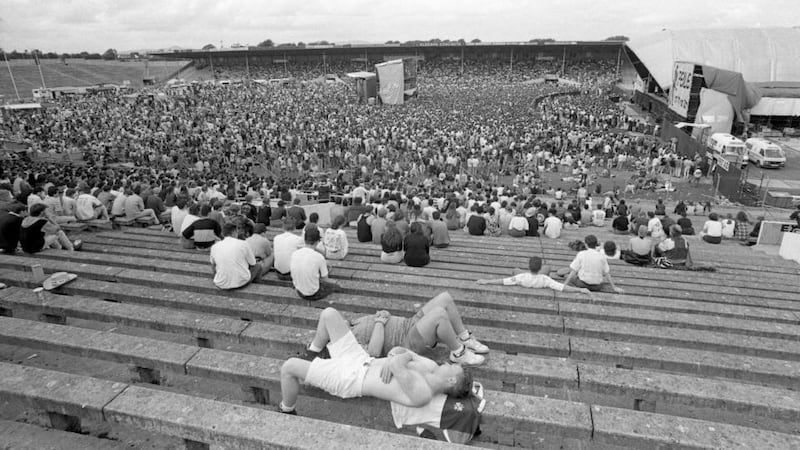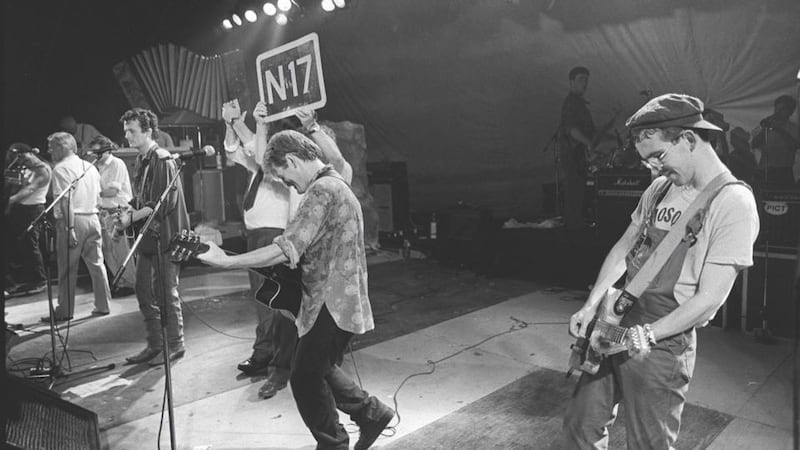It was a hell of a year. It was the year Ireland went to the World Cup in Italy and the country turned upside down and inside out. It was the year Nelson Mandela was released from prison in South Africa, the year the Berlin Wall was officially demolished, the year Saddam Hussein sent Iraqi troops into Kuwait, the year the United States went in to get them out and the year The Simpsons aired for the first time.
And 1990 was also the year when a generation of Irish youngsters began to associate Semple Stadium, in Thurles, with live music rather than hurling. Twenty-five years ago this weekend the first Féile music festival took place in the Co Tipperary town.
Whatever about the run of seismic events elsewhere in the world that year, Féile was groundbreaking in Irish pop culture. There had been plenty of music festivals before, shindigs such as the Mountain Dew Festival, in Macroom, Siamsa Cois Laoi, in Cork, and Lisdoonvarna, in Co Clare, but they were all in the past. The kids who were coming of age in 1990s Ireland wanted their own party – and a campsite.


Féile gave them that and more. For five heady years the festival welcomed music fans, freaks, head-the-balls, messers, chancers, eejits, rogues, hard chaws and musicians to Thurles. There were probably some “revellers” in the mix too.
The hordes came, caroused and left the town needing a clean-up on the bank-holiday Monday. The residents experienced every emotion over the five years, from unsuspecting and welcoming to eager to cash in and, finally, fed up.
After five years in Thurles, Féile moved to Cork in 1995, called to the Point in Dublin in 1996 and went back to Co Tipperary for a one-day bash in 1997. It was never the same as it was during the first five years, though, and it’s those weekends at Semple Stadium that ensure the festival’s legend.
Féile was the first modern Irish music festival. Without Féile there wouldn’t be the bacchanalian excesses of Witnness and Oxegen – and you can join the dots between Féile and Electric Picnic with relative ease.
The RTÉ broadcaster Will Leahy has been delving into the festival's history for his radio documentary Féile: The Untold Story of the Trip to Tipp.
Back in 1990, he says, very few outdoor music events were on the summer calendar. “People may find that bizarre now, but there was nothing. There was no rite-of-passage festival, there were even few big gigs. In 1989, which was my Leaving Cert year, there was no major outdoor gig. Then, in a year of monumental change worldwide, Féile came along.”
Trip to Tipp
The Féile backstory begins in September 1989, with the homecoming for the All-Ireland-winning Tipperary hurling team and a performance at Semple Stadium that night by
Joe Dolan
.
Michael Lowry, the local TD, was chairman of the stadium's management committee. He looked at the reaction to Dolan, saw the £1.2 million debt the stadium was carrying after the 1984 GAA centenary celebrations and reckoned a gig might bring in cash. Eamonn McCann of MCD Concerts showed the most enthusiasm, and the Trip to Tipp was born.
Lowry's role was key. Eugene Hogan of the Tipperary Star says that "he was the only person who could put this together. He was a risk-taker and could bring people with him to enable this to happen."
Leahy agrees. “Whatever you might think of Michael Lowry the politician, this was Michael Lowry the GAA man. The GAA were faced with the prospect of losing Semple Stadium and seeing it turned into a housing development if they didn’t do something about the debt.
“They had to come up with something, and that allowed him to sell the concept to the county board, despite the huge opposition on the county board to the idea of a rock festival on the sacred soil of Semple Stadium.
“It couldn’t have happened without his political know-how. You needed someone who could weave the local council, the guards, the health board, the GAA and the residents together, and he was the only man who was common to all those interested parties.”
The 1990 line-up would not set pulses racing today. “It was quite parochial the first year,” says Leahy of a bill topped by Meat Loaf, Van Morrison and the Hothouse Flowers. “But it felt like an international music festival by the second and third years. You can see the evolution of the line-up and the promoters realising they were on to something. They could see there was a market for what they were doing in Thurles. The fact that it was in Thurles meant it was something quite unique and different. It was in the middle of the country, easy to get to, and the locals welcomed it with open arms.”
Irish acts
During its pomp Féile had its pick of international acts. But while the event attracted Simply Red,
Iggy Pop
, INXS,
Deacon Blue
, The Prodigy, Blur and Björk, it also packed in Irish acts.
Christy Moore
, The Pogues, Therapy, The Sawdoctors, Chris de Burgh and The Stunning all featured near the top of the bill.
"The breadth of success of Irish acts at the time was unprecedented and never seen since," says Leahy. "When you talk to the bands who played Féile they point out how different things were then. You'd one radio station, one TV channel to speak of and one music festival. If you were an Irish band who were played on 2FM, who got a slot on The Late Late Show and played Féile, you got a year's work out of it. You got to your target market with ease. People still remember the hits from those bands 25 years on."
His documentary has many colourful tales about the exchanges between the Féile faithful and the people of Thurles. Lowry recalls “a sense of fear about what was to arrive” the first year and watching “a scruffy-looking crowd” going past his office.
There were complaints about religious cults drumming and keeping residents awake. One of those locals, Archbishop Dermot Clifford, came out very strongly against Féile. “Bishops had far more influence then than they would now,” Lowry says, and the archbishop’s opposition generated a lot of publicity.
“The Ireland of today and the Ireland of 1990 are two different worlds, but 1990 was when things started to change and tilt right across the board,” says Leahy.
Within a few years the circus had left town. “Once the debt was paid it was very hard to sell it to the local community,” says Leahy. “The man who was the driving force, Michael Lowry, became a cabinet minister in 1994, so he hadn’t the interest to be the man on the ground taking care of Portaloos, gardaí and campsites.”
Rite of passage
Féile set a template. It was the rite-of-passage summer festival and the big annual gathering for young Irish people getting away from their parents for the first time. Witnness and Oxegen followed in the next decade with much the same mix of big bands, little bands and camping.
“We have no similar rite-of-passage festival now,” Leahy says. “And Electric Picnic’s age demographic has got younger to reflect that. The average school-leaver probably sees the Electric Picnic as their rite-of-passage event.”
But the festivals of today are very different affairs from the unbridled Féiles of old. “Today there wouldn’t be the opportunity for locals to make money by having a chip van parked in their driveway,” Leahy says. “The famous ‘subject to licence’ didn’t come in until 2000. Most of the waste-management regulations came in the Waste Management Act of 1996.
“I’m not saying it was the wild west in 1990, but it was certainly a far less regulated Ireland. I don’t think the regulated-Irish-festival story is half as interesting as Féile.”
They were there: Musicians remember Trips to Tipp
Steve Wall, The Stunning: "Driving into Thurles, it was like Sodom and Gomorrah, like a scene from a Mad Max film or something. People had set up stalls in their front gardens, selling bowls of cornflakes, cups of tea and anything they could sell."
Leo Moran, The Sawdoctors: "We felt under pressure to put on a show. It was a time before big screens, so we felt we needed something more than singing to captivate the crowd. We had Mike Scott, a troupe from Macnas and someone going across the stage on a Honda 50."
Tom Dunne, Something Happens: "It was like the fall of Rome. There was no catering, no toilets. People were buying large sliced pans and packets of ham in shops and sitting at the side of the road to eat them."
Iggy Pop: "I was coming to Ireland, and it was summer, and I thought it would be a lovely green place, kind of like a Renaissance fair, with people playing flutes and singing folk songs. Instead it was 20,000 really intense little Irish people going, 'Up yours, Iggy,' and it got me really nuts. And I enjoyed it."
Féile: The Untold Story of the Trip to Tipp is on RTÉ Radio 1 on Monday at 2pm











